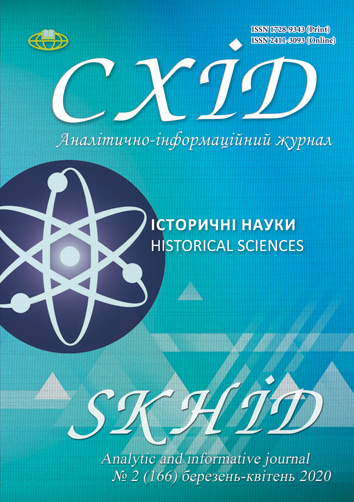Vietnam’s foreign policy and its Ukrainian aspect in the context of the historical and political processes of modern time
DOI:
https://doi.org/10.21847/1728-9343.2020.2(166).201901Keywords:
modernization, renovation, non-alignment, ASEAN, APEC, ASEM, WTO, UNIDO, joint intergovernmental commissionAbstract
The article examines the process of forming Vietnam’s foreign policy in the context of the historical and political processes of the country in recent history. Paying tribute to the Asian conservatism and seeing a reform of the political system as a threat to the foundations of the statehood and national unity, the Vietnam leaders has chosen its path of social modernization - a “renovation” strategy (in Vietnamese - “Đổi Mới”) that has transformed the country within twenty years into another Asian tiger. The “renovation” course was to allow the policy of “open doors” in foreign economic relations. External factors for the successful development of the Vietnam’s foreign policy include the ASEAN membership. Due to the many political and socio-cultural factors common to Vietnam and the ASEAN member states (Vietnam joined ASEAN in 1995) and the continued political stability of the country, Vietnam has achieved a particular favor from the investors and trading partners of this association. Considerable attention in the article has also been paid to analyzing the development of political and trade-economic relations between Vietnam and Ukraine in the context of multilateral cooperation. The establishment of diplomatic relations between the two countries and signing the key bilateral agreements has been analyzed. The absence of fundamental differences on key international issues as well as the willingness to develop friendship and mutually beneficial partnership has created the favorable conditions for cooperation between Ukraine and Vietnam within the international organizations. There is much in common in our countries’ positions on the proliferation of nuclear weapons and other weapons of mass destruction, counter-terrorism, reform of the United Nations etc. Ukraine and Vietnam have traditionally supported each other’s nominations for election to the governing bodies of international organizations.Downloads
References
Albuyeh, R., & Paradis, M. (2018). Thawing Rivalries and Fading Friendships: An Experimental Approach to Rapprochement and Alienation. Political Psychology, 39(4), 811-827. DOI: https://doi.org/10.1111/pops.12441
Angie Ngoc, T., & Crinis, V. (2018). Migrant Labor and State Power: Vietnamese Workers in Malaysia and Vietnam. Journal of Vietnamese Studies, 13(2), 27-73. DOI: https://doi.org/10.1525/vs.2018.13.2.27
Bilorus, O. H. (2009). Ukrayina v systemi hlobalnykh transformatsiy. Hlobalizatsiya i hlobalne upravlinnya: istorychnyy, sotsialnyy ta politolohichnyy vymiry. Kyiv (In Ukrainian).
Carlile, A. (2019). Thayer Background Brief. Vietnam’s Intervention in Cambodia: Invasion or Liberation? Thayer Consultancy Background Brief. Retrieved from https://ru.scribd.com/document/396717036/Thayer-Background-Brief-Vietnam-s-Intervention-in-Cambodia-Revisited-1979-2019
Elliott, David W.P. (2014). Changing worlds: Vietnam’s Transition from Cold War to Globalization. Oxford University Press.
Hieu Huu, N. (2020). Impact of Foreign Direct Investment and International Trade on Economic Growth: Empirical Study in Vietnam. Journal of Asian Finance Economics and Business, 7(3), 323-331. DOI: https://doi.org/10.13106/jafeb.2020.vol7.no3.323
Hryshchenko, K.I. (2011). Ukrayina hraye svoyu hru. Den, Mars, 22 (In Ukrainian).
Kudryachenko, A. I. (2010). Yevropeyskyy vybir Ukrayiny: dosyahnennya, problemy i perspektyvy. Viche. 18: 3-4. (In Ukrainian).
Kudryachenko, A. I., Rudych, F. M., Khramov, V. O. (2004). Heopolityka. Kyiv. (In Ukrainian).
Lai, C. (2019). A Coercive Brotherhood: Sino-Vietnamese Relations from the 1990s to 2018. Journal of Contemporary China. DOI: https://doi.org/10.1080/10670564.2019.1645484
Lokshin, G. M. (2019). Nguyen Co Thach - architect of modern diplomacy of Vietnam; Nguen Ko Tkhat’ - tvorets sovremennoi diplomatii V'etnama. Aziya i Afrika segodnya (8). DOI: https://doi.org/10.31857/s032150750005789-9
Ly, Bang (1990). “Diplomatic Diary” and “Cooperation for Peace”. Retrieved from http://vietnam.org/chengdu-1990/ly-bang-tiet-lo-hoi-nghi-thanh-do-1990.html.
Madisson, V. V., Shakhov, V. A. (2003). Suchasna ukrayinska heopolityka. Kyiv: Lybid, S. 56-59. (In Ukrainian)
Nguyen Co Thach (2013). Architect of the Modern Vietnam’s Diplomacy. Pam Doan Nam. Retrieved from https://baoquocte.vn/ (In Viet.)
Nguyen Hoang, L., Luong Vinh Quoc, D., & Bui Hoang, N. (2019). Effects of Foreign Direct Investment and Human Capital on Labour Productivity: Evidence from Vietnam. Journal of Asian Finance Economics and Business. 6(3), 123-130. DOI: https://doi.org/10.13106/jafeb.2019.vol6.no3.123
Reeves, J. (2018). Imperialism and the Middle Kingdom: the Xi Jinping administration’s peripheral diplomacy with developing states. Third World Quarterly, 39(5), 976-998. DOI: https://doi.org/10.1080/01436597.2018.1447376
Schuler, P. (2020). VIETNAM’S FOREIGN POLICY UNDER DOI MOI. Pacific Affairs. 93(1), 220-222.
Seagren, C. W., & Henderson, D. R. (2018). Why We Fight A Study of U.S. Government War-Making Propaganda. Independent Review. 23(1). 69-90.
Tran Quang Co. (2005). Memories. State political edition’s house. Hanoi.
Turcsanyi, R. Q. (2014). The distribution of power in east asia in the post-crimea world: the un-checked china's rise?
Vyznannya Ukrayiny dyplomatychne (2004). Ukrayinska dyplomatychna entsyklopediya. Vol.1. Kyiv, 194-200 (In Ukrainian).
Downloads
Published
How to Cite
Issue
Section
License
Copyright (c) 2020 Andriy Kudryachenko, Yevhen Prypik

This work is licensed under a Creative Commons Attribution-NonCommercial-NoDerivatives 4.0 International License.
1. Authors bear responsibility for the accuracy of facts, quotations, numbers and names used.
2. Manuscripts are not sent back.
3. The publisher does not always agree with the authors' opinion.
4. The authors reserve the right to authorship of the work and pass the first publication right of this work to the journal under the terms of a Creative Commons Attribution-NonCommercial-NoDerivatives 4.0 International License. This license allows others to distribute (copy) the published work for non-commercial purposes, provided there is mandatory attribution to its authors and a link to the first publication in our journal.
5. The authors have the right to conclude separate supplement agreements that relate to non-exclusive work distribution in the form in which it has been published by the journal (for example, to upload the work to the online storage of the journal or publish it as part of a monograph), provided that the reference to the first publication of the work in this journal is included.

